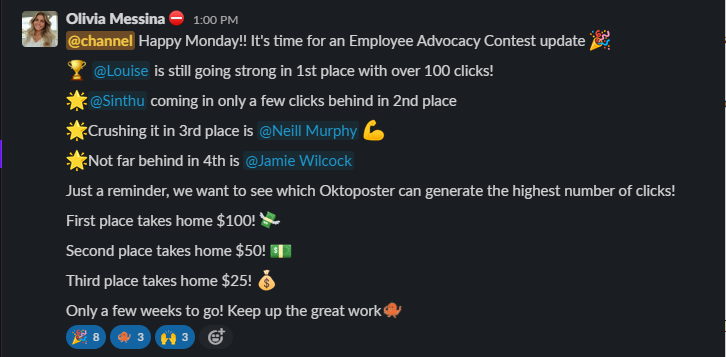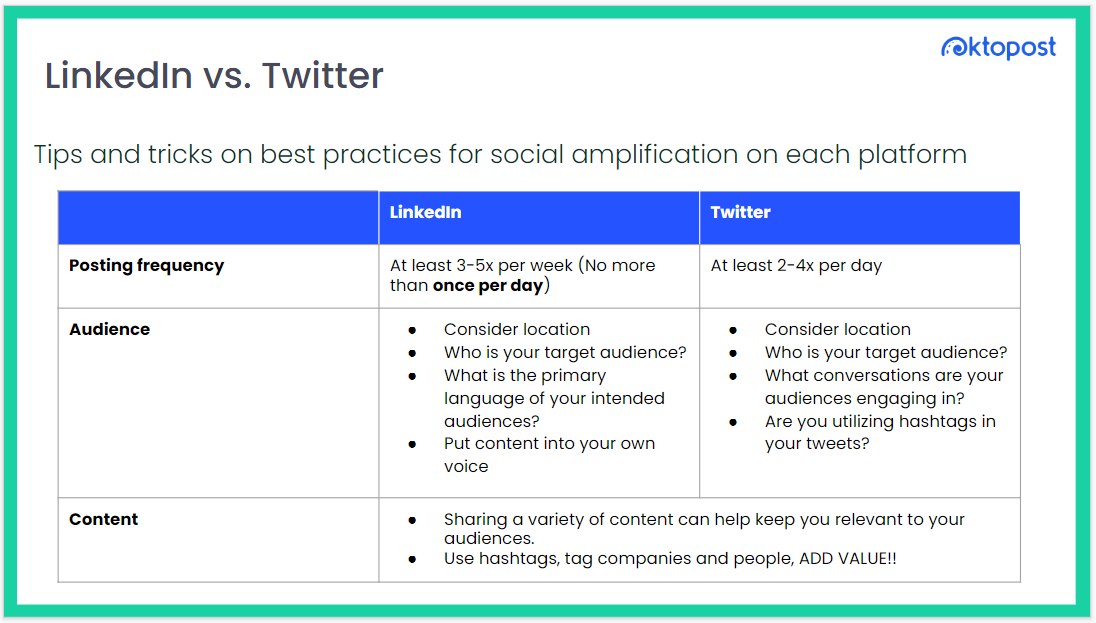Employee advocacy is one of the most effective ways to improve a company’s image and brand awareness, yet most companies neglect to give their team members the motivation necessary to create this type of content.
Failing to incentivize employee advocacy can have a dramatic impact on your online presence. In fact, employee advocacy programs lead to a 25% to 40% increase in social media engagement.
Strong employee advocacy practices generate positive results for everyone involved:
- You’ll receive more social traffic.
- Your audience will be more connected to your brand.
- Your team members will get extra perks in exchange for their contributions.
In this article, we’ll explain how to effectively incentivize employee advocacy within your business and keep your advocates engaged in your program.
Quick Jump Links
The challenges of incentivizing employee advocates
No matter what your company or how strong your brand is, employee advocacy will always come with certain challenges.
Employee advocacy demands time from your employees
Employee advocacy posts help your business, but how do you convince your employees to take the time to craft marketing content? Companies encounter a number of common challenges when trying to generate enthusiasm for advocacy content.
For example, your team may feel that they are being expected to do extra work without receiving any additional appreciation or compensation for the time and effort.
If they are already contributing to the business in their day-to-day responsibilities, why should they go even further to post content on their own?
Remember that employee advocacy is outside the job description of most employees — even those who work in marketing or growth. Asking employees to post brand-related content on their personal social media profiles is a significant request.
How to mitigate that challenge:
You should never make employee advocacy mandatory, and you should always offer incentives to team members who are willing to go above and beyond to support the business.
Along with these incentives, it’s also important for the team to understand how their posts can impact the brand’s trajectory.
A clear employee advocacy strategy will show them exactly why their contribution is important and how it will help your company develop a stronger presence on social media (and other marketing channels). You should also provide assets, templates, and other resources to make it easier for them to craft engaging employee advocacy content.
Employee advocacy naturally ebbs and flows
No matter how engaged your advocates are, nor how amazing your advocacy content is, there are natural ebbs and flows to advocacy that happen throughout the year.
In fact, when we benchmarked advocacy activity throughout 2021, we found that there were natural peaks throughout the year that followed typical B2B sales cycles.

How to mitigate that challenge:
While that’s normal, it’s important to incentivize advocacy participation from time to time to not let these ebbs turn into a dead program.
Remember, it’s a lot easier to increase momentum from a slow pace than start momentum from a dead stop.
By incentivizing your advocacy program, showing how their posts are making an impact on the company, and getting employees excited about their own thought leadership, you’ll keep even baseline momentum throughout the year.
4 ways to incentivize employees to become advocates for your business
At this point, you’re ready to consider the right incentives to maximize the impact of your employee advocacy program. Keep in mind that different people respond to different things. It’s critical to tailor your incentives to the unique personalities and skill sets of each unique member of the company.
Similarly, some employee advocacy posts are more valuable than others. A C-level executive with ten years of experience and 5,000 LinkedIn connections can generate more engagement than a new hire who is new to the industry and has little or no social media presence. Naturally, incentives should be adjusted based on the employee’s reach and impact.
1. Financial bonuses
Unsurprisingly, the most straightforward way to incentivize employee advocacy content is money. This could take the form of cash or similar benefits such as gift cards or prepaid credit cards. While money doesn’t exactly come with the most personal touch, it offers universal appeal and is easy to budget for.
In fact, in early 2022, we held an employee advocacy competition where we offered a cash prize to the advocate who earned the most link clicks over a quarter. We ended up increasing our own conversions from social media by 266%.

LinkedIn Premium is a slightly more unique alternative — while it has a monetary value, its true value is in the professional opportunities it can unlock for that particular employee. Of course, you should consider simply offering LinkedIn Premium to all relevant teams if you think it will boost their performance.
2. Education and training
Just like LinkedIn Premium, education and training can help team members achieve their career goals. This kind of perk may be more difficult to offer since different employees will be looking for different types of professional development. At the same time, that also makes it an even stronger motivator in cases where the benefit is well-suited to the team in question.

A slide from our deck when educating our advocates about posting on social media.
In particular, managers, executives, and other high-level employees may be more interested in education and training compared to other benefits such as monetary incentives. Don’t be afraid to ask your team members directly to learn exactly what would motivate them to post more employee advocacy content.
3. Recognition
It’s easy to lose sight of the importance of direct recognition, especially in the current era of remote work. The truth is that recognition is a simple, yet effective, tool that managers can use to incentivize strong performance and maintain that performance over time.
In fact, employees that feel recognized at work are up to 90% less likely to report feeling burnt out. They’re also as much as twice as likely to offer positive evaluations of their current lives and future outlooks.
Whether your organization is remote, in-person, or hybrid, you should be making employee recognition a priority whenever possible. Recognizing team members for top-performing employee advocacy posts is a low-cost, low-effort way to make them feel more valued and ensure that your team continues to create valuable content.
4. Employee bonding events
Catered lunches, happy hours, retreats, and other bonding events can motivate your employees while also helping your team grow stronger by developing stronger relationships. These can take place in the office or at another location depending on the event in question.
However, it’s critical to be careful when offering this kind of incentive. If only top contributors are allowed to participate, the rest of your team may end up feeling excluded or left out. On the other hand, events won’t offer as much motivation for individual success if you invite everyone regardless of their results.
One way to address these concerns is to include everyone and then present individual awards during the event. This is also a great opportunity to recognize your top performers in front of the entire department or organization. It’s important to balance recognition for individual success with group bonding and inclusion for all team members.
3 benefits of incentivizing employee advocacy across your business
1. Generate outreach
Employee advocacy enables brands to get the word out to a wider audience than would otherwise be possible. Along with the company’s existing leads, you can connect to everyone in your employees’ networks such as friends, family members, and former coworkers. These leads would be much more difficult to target without an employee advocacy program.
If an employee advocacy post is successful, readers will click through to learn more about your brand or products. That will help you reach out to more customers as well as candidates, generating strong momentum for the entire business. Even better, this comes at a relatively low cost compared to many other forms of lead generation.
2. Maximize employee engagement
On top of outreach, employee advocacy also creates a positive feedback cycle that can help create positive changes within the organization itself. Employee advocacy should have just as much of an effect on your team members and internal culture as it does on the bottom line.
First, team members should feel valued through the incentives that you offer in exchange for their employee advocacy posts. While gift cards and other monetary benefits can work well, they’re often even more effective when coupled with perks that come with a more personal touch. Internal recognition is one of the most underrated perks — simply letting an employee know they’re valued can go a long way.
Posting employee advocacy content also helps employees build their reputations as thought leaders in their field. Remember that these kinds of posts don’t have to be entirely about your brand. They should also highlight the unique skills and contributions of the team members posting them. This is just one example of how a strong employee advocacy program is good for all stakeholders.
3. Improve your brand image
Your brand image won’t transform overnight, but you’ll take a step in the right direction by incentivizing employee advocacy posts. The more positive things audiences hear about the business, the more likely they’ll be to engage later on.
One of the most common mistakes marketers make is thinking that every interaction should lead to a conversion. In many cases, a lead will need to engage with your brand several times before they’re ready to make a purchase. Employee advocacy posts are powerful at the top of the sales funnel because they produce a strong first impression without pushing the reader toward a purchase or subscription.
—-
It doesn’t matter whether you have 20 employees or 20,000 — employee advocacy content is one of the best investments you can make in terms of outreach, employee engagement, and overall brand image. Hopefully, these tips gave you a good idea of what a thriving employee advocacy program should look like.
Of course, creating that kind of program is easier said than done. Don’t hesitate to book an Oktopost demo today to learn how we help organizations of all sizes set up and manage successful employee advocacy programs.

Source link


